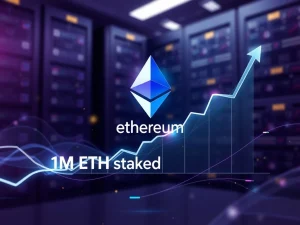Bitcoin Hashrate: Unprecedented Surge to 955 EH/s Ignites Global Mining Confidence

Are you ready for some groundbreaking news from the world of digital gold? Bitcoin, the undisputed king of cryptocurrencies, has just shattered another record, showcasing its incredible resilience and the unwavering commitment of its global mining community. The Bitcoin hashrate, a critical metric indicating the total computational power dedicated to processing transactions and securing the network, surged to an unprecedented 955.75 exahashes per second (EH/s) between July 27-28, 2025. This remarkable achievement is more than just a number; it’s a powerful testament to the network’s growing strength, heightened miner confidence, and robust infrastructure upgrades worldwide.
Understanding the Power Behind Bitcoin Hashrate
Before we dive deeper into the implications of this monumental surge, let’s quickly grasp what the Bitcoin hashrate actually means. Simply put, it’s the measure of how much computing power is being used by miners to find the next block on the Bitcoin blockchain. The higher the hashrate, the more secure and resilient the network becomes against potential attacks. Think of it as a global competition where millions of specialized computers (miners) are racing to solve complex cryptographic puzzles. The first one to solve it gets to add the next block of transactions to the blockchain and earn newly minted bitcoins.
Why is this important?
- Network Security: A higher hashrate means it’s exponentially more difficult for a malicious actor to gain control of the network (a 51% attack), making Bitcoin more secure.
- Miner Confidence: Miners invest significant capital in hardware and energy. A rising hashrate indicates that miners are confident in Bitcoin’s future profitability and long-term viability.
- Decentralization: While large mining pools exist, the global distribution of mining operations contributes to the network’s decentralized nature.
The Unprecedented Surge in Bitcoin Mining
The recent record-breaking Bitcoin hashrate, fluctuating between 932 EH/s and 955.75 EH/s, didn’t happen by accident. It’s the culmination of strategic investments and expansion efforts by leading firms across the globe. Companies like Marathon Digital and Riot Platforms are at the forefront, pouring resources into more efficient hardware and increasingly embracing renewable energy sources to power their operations. Fred Thiel, CEO of Marathon Digital, highlighted this trend, emphasizing that the hashrate’s rise directly reflects a strong commitment to operational effectiveness and infrastructure growth.
This expansion is a clear signal:
- Miners are upgrading to the latest generation of Application-Specific Integrated Circuits (ASICs), which are significantly more powerful and energy-efficient.
- New mining facilities are coming online in regions with favorable energy costs and regulatory environments.
- Existing operations are optimizing their infrastructure to maximize output and minimize downtime.
The sheer scale of these operations is impressive. For instance, mining firm BitFuFu reported achieving a hashrate of 36.2 EH/s and utilizing a staggering 728 megawatts of power in June, showcasing the massive energy commitment required to maintain competitiveness in the Bitcoin mining landscape.
Bitcoin Mining Challenges and Innovations
While the surge in hashrate is a positive sign for Bitcoin’s security, it also intensifies competition among miners. The network difficulty, which reached an astounding 126 trillion in June 2025, automatically adjusts to the rising hashrate, making it harder to mine blocks. This pushes miners to allocate even greater energy and computational resources, creating a dynamic environment where efficiency is key. For smaller miners, this can be a significant challenge, as they often lack the capital to invest in the latest, most efficient hardware or secure access to cheap, abundant energy.
Consider the following challenges and how the industry is innovating:
| Challenge | Innovation/Adaptation |
|---|---|
| Rising Energy Costs | Increased adoption of renewable energy sources (solar, wind, hydro), utilization of flared natural gas. |
| Intensified Competition | Investment in next-gen ASICs, optimizing cooling systems, diversifying revenue streams. |
| Operational Scalability | Building large-scale, purpose-built mining facilities with advanced infrastructure. |
| Shrinking Profit Margins | Diversification into adjacent industries like AI data centers and high-performance computing (HPC). |
Even large-scale operations face hurdles. For example, the network’s resilience was briefly tested in Texas, where miners temporarily reduced energy use to avoid peak demand charges, showcasing the delicate balance between profitability and grid stability. However, this also highlights the network’s adaptability.
Network Security and Decentralization: A Deeper Look
The soaring network security provided by the record hashrate reinforces Bitcoin’s foundational promise: a decentralized, immutable ledger. Every new exahash added to the network makes it more robust against attacks, ensuring the integrity of transactions and the security of user funds. This enhanced security is paramount for Bitcoin’s long-term viability and its increasing acceptance as a global reserve asset.
Despite the trend towards industrial-scale operations, the decentralized spirit of Bitcoin occasionally shines through in remarkable ways. A solo miner, operating with a modest 2.3 petahashes (a tiny fraction of the overall network), successfully claimed a block in July. This rare feat underscores that while economies of scale favor larger players, the network remains open for anyone to participate, reinforcing its decentralized ethos. This incident serves as a powerful reminder that the network’s security isn’t solely dependent on large corporations but on the collective, distributed effort of all participants.
Institutional Adoption and Market Impact
The implications of this hashrate surge extend far beyond just mining operations; they are profoundly influencing crypto market dynamics. The growing confidence among miners is mirrored by a significant increase in institutional adoption. Corporate entities like MicroStrategy and Metaplanet now hold over 1,000 BTC each, signaling a strategic shift towards Bitcoin as a primary reserve asset. This trend validates Bitcoin’s role not just as a speculative asset but as a legitimate store of value and a hedge against traditional financial uncertainties.
The market has reacted with heightened activity. Open interest in Bitcoin futures recently hit record levels, indicating increased speculative activity. While a $44.5 billion open interest milestone coincided with a price decline in July, this volatility is characteristic of a maturing yet still developing market. Analysts note a complex interplay between hashrate, energy costs, and market sentiment, often correlating the hashrate’s rise with Bitcoin’s price movements. For instance, Bitcoin’s recent all-time high of $93,000 in July 2025 further highlights this intricate relationship, suggesting that network strength often precedes or accompanies significant price appreciation.
Navigating Crypto Market Dynamics: What’s Next for Bitcoin?
The record Bitcoin hashrate reflects a broader, profound confidence in Bitcoin’s long-term viability, not just as a financial asset but as a foundational decentralized infrastructure for the future. Strengthened network security, coupled with the accelerating pace of institutional adoption, is likely to expand Bitcoin’s role within global financial systems. However, the journey isn’t without its considerations.
Key areas to watch include:
- Sustainability: The energy consumption of Bitcoin mining remains a critical discussion point, pushing miners towards greener solutions.
- Regulatory Frameworks: Evolving global regulations will continue to shape the environment for mining and Bitcoin adoption.
- Technological Innovation: As block subsidies continue to halve, miners must continually innovate to balance energy consumption, profitability, and technological advancements.
The constant evolution of the hashrate, difficulty adjustments, and miner strategies will continue to define the landscape of Bitcoin mining and its impact on the broader crypto ecosystem. As Bitcoin matures, its fundamental strengths, amplified by a robust and secure mining network, position it for continued growth and integration into the global economy.
Conclusion
The surge of Bitcoin’s hashrate to an unprecedented 955.75 EH/s is a monumental milestone, signaling robust health and profound confidence in the network’s future. This record-breaking achievement, driven by global Bitcoin mining expansion and strategic infrastructure upgrades, significantly bolsters network security and underscores Bitcoin’s growing role in global finance. From the increasing institutional adoption by major corporations to the intricate interplay with crypto market dynamics, the hashrate’s ascent paints a picture of a resilient, evolving, and increasingly vital digital asset. As Bitcoin continues to solidify its position, its underlying strength, powered by a dedicated global mining community, ensures its enduring relevance in the decentralized future.
Frequently Asked Questions (FAQs)
1. What is Bitcoin hashrate and why is its record high significant?
Bitcoin hashrate is the total computational power used by miners to secure the Bitcoin network. A record high, like the recent 955.75 EH/s, signifies enhanced network security, making it exponentially harder for malicious actors to attack. It also indicates strong miner confidence and increased investment in mining infrastructure globally.
2. How does the rising hashrate impact Bitcoin’s network difficulty?
The Bitcoin network automatically adjusts its mining difficulty every 2016 blocks (roughly every two weeks) to ensure that new blocks are found approximately every 10 minutes. When the hashrate increases, the difficulty adjusts upwards, making it harder to mine blocks and maintaining the consistent block production time. This intensified competition requires miners to invest more resources to remain competitive.
3. What role do companies like Marathon Digital and Riot Platforms play in this hashrate surge?
Leading publicly traded mining companies like Marathon Digital and Riot Platforms are significant contributors to the hashrate surge. They invest heavily in large-scale operations, acquire advanced, energy-efficient mining hardware (ASICs), and often focus on integrating renewable energy sources. Their strategic expansions and infrastructure upgrades are key drivers behind the overall growth in network computing power.
4. How does Bitcoin’s hashrate correlate with its price and market dynamics?
While not a direct cause-and-effect, a strong correlation often exists between Bitcoin’s hashrate and its price. A rising hashrate indicates a healthy, secure, and growing network, which can inspire investor confidence and potentially lead to price appreciation. Conversely, higher prices can incentivize more miners to join, further boosting the hashrate. This interplay is a key aspect of crypto market dynamics.
5. What challenges do smaller Bitcoin miners face amid this industrial-scale expansion?
Smaller miners face significant challenges due to the increasing difficulty and the high capital expenditure required for competitive mining. Industrial-scale operations benefit from economies of scale, access to cheaper energy, and bulk purchases of the latest hardware. Smaller miners must prioritize energy efficiency, seek out niche opportunities, or join mining pools to pool their resources and increase their chances of earning rewards.
6. Is Bitcoin mining sustainable given its energy consumption?
The sustainability of Bitcoin mining is a complex and evolving topic. While it does consume significant energy, there’s a growing trend towards utilizing renewable energy sources (hydro, solar, wind) and otherwise wasted energy (like flared natural gas). Many large mining operations are actively pursuing greener energy solutions, and innovations in hardware efficiency are continuously reducing the energy required per hash. The industry is moving towards a more sustainable model, but it remains a critical area of focus and development.










